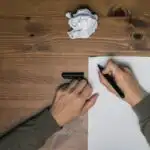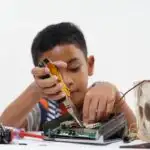The 4th grade is a transformative time in a child’s life. The ages of nine and ten are pivotal in terms of social relationships and friendships, where children develop their social skills.
In turn, this helps them discover who they are, who their friends are, and it’s the time many of us start to think about the world around us.

It’s also a time when children start to think more deeply about certain things, with questions about, well, anything and everything (if you’re a parent, you know all about this!)
To help a fourth grader’s mind grow and develop even more, teachers can set up fun science experiments for kids to enjoy. Not only are these projects super enjoyable, but they are also educational, engaging children in the world of science.
Science is vital for STEM-based activities, helping young minds develop their critical thinking skills, collaboration abilities, and become more effective at communication.
Today, we have chosen the best 4th grade science projects to inspire nine to ten-year-olds.
Each science experiment in today’s list is designed to be engaging and interactive, encouraging students to ask questions, make observations, and form hypotheses.
They will get to conduct experiments, collect data, and draw meaningful conclusions, all while having fun along the way.
Whether your children or students are interested in exploring the natural world, investigating the laws of motion, or discovering the wonders of electricity, our 4th grade science projects offer a variety of options to cater to their interests.
Each one takes into account their developmental stage, providing age-appropriate challenges.
So, let’s get started and watch as fourth graders become confident and enthusiastic young scientists!
Why Science Projects Are Important For Fourth Graders
Science projects play a vital role in the development of fourth graders for several important reasons.
Firstly, these projects foster a sense of curiosity and wonder about the world around them. By engaging in hands-on experiments and investigations, fourth graders learn to ask questions, make predictions, and explore scientific concepts in a practical and meaningful way. This helps cultivate a lifelong love for learning and encourages critical thinking skills.
Secondly, science projects provide fourth graders with an opportunity to develop essential skills such as problem-solving, observation, and analysis.
As they design and conduct experiments, students learn to formulate hypotheses, collect data, and draw conclusions based on evidence. They also develop skills in organization, record-keeping, and presenting their findings, which are valuable in both scientific and everyday contexts.
Furthermore, science projects encourage collaboration and teamwork. Fourth graders often work in groups or pairs, allowing them to learn from and contribute to the ideas of their peers, something vital for this age group.
This collaborative environment builds communication skills, cooperation, and the ability to work effectively as part of a team.
Finally, science projects help fourth graders understand the relevance and application of scientific concepts in the real world.
By exploring topics like environmental science, biology, or physics, students gain a deeper appreciation for how scientific principles impact their daily lives. They also begin to understand the importance of responsible and ethical scientific practices.
Science projects For 4th Graders
1. Hovercraft Design
We start with an experiment that showcases the remarkable capabilities of air.
By designing a floating hovercraft, students can learn about the effects of friction and air pressure. Find out how to make a hovercraft here.
2. Anemometer
Unearth the velocity of wind using a personalized anemometer! Basic principles of earth science are unveiled through a straightforward garden device created from paper cups, straws, tape, a pencil, and a thumbtack.
3. Newton’s Law
Demonstrate how Newton’s Law of Gravity works by gently pulling a string of beads, causing them to gradually descend from the cup. Follow the guide here to find out how to do so.4.
4. Working Lung Model Design
Delve deeper into the captivating natural phenomenon of respiration by creating a functional lung model!
You can do this using readily available materials such as straws, a plastic bottle, sticky tape, balloons, and scissors.
5. Blood Components
We stick with the human body with this fascinating project discovering more about blood components.
When working with fourth graders, it is crucial to approach biology in a fun and simplified manner while highlighting its significance in life! And, this project is the perfect way to do so!
You can engage students in an exciting exploration of blood components by creating “blood” model jars, allowing them to gain a deeper understanding of this essential aspect of biology.
6. Create a Microscope
Ignite enthusiasm in your students for STEM with this amazing project!
Witness the awe-inspiring phenomenon of water droplets curving to form a convex lens, leading to the refraction of light and the remarkable magnification of objects. Here’s how to tackle this fun science project!
7. The Science Behind Clouds
At number seven, we enter the captivating world of cloud science with this exhilarating project!
Through the use of a paper cup, tape, plastic zip-top bag, and water, your fourth graders will swiftly grasp the concept of the water cycle.
They will witness firsthand how water transitions from the ground into the air, forming clouds, and eventually returning to the Earth as rain.
8. Chameleons Color Changes
Find out how chameleons change color using an interactive poster that dazzles students with an invigorating color show.
As the middle wheel spins, this mind-blowing display demonstrates the equally mind-boggling ability of chameleons to change their colors.
9. Creating a Paper Flashlight
Uncover the fundamental rules of simple electric circuits while crafting a clever paper flashlight!
This exciting project is an ideal hands-on experiment for children, especially those aged ten to eleven, offering a captivating exploration of the science behind batteries.
10. Simulate an Earthquake
Experience the fascinating world of seismology through this hands-on experiment. Begin by setting a dish of jelly and then proceed to construct a structure on top of it.
Once the structure is complete, gently wobble the dish, causing the jelly to shake and disrupt the structure. This jelly-tastic demonstration vividly illustrates the principles of seismology.
11. A Lemon Volcano
Time to create an erupting lemon volcano! With ordinary household supplies, fourth graders will have a blast while exploring the properties of acids and bases.
Through this interactive project, they will witness firsthand how the interaction between these substances triggers a fascinating chemical reaction.
12. Make Crystal Names
Infuse science with fun by allowing students to grow edible, crystallized versions of their names using pipe cleaners. This exciting project is just one example of the many tasty, edible science projects available for kids!
A perfect opportunity to encourage creativity and exploration as students take a deep dive into scientific experimentation.
13. Walking Water Rainbow
In this fun-packed experiment, students use paper towels, water, and food coloring to observe capillary action and color mixing, fostering a hands-on understanding of water absorption and the science of gradients.
It is a perfect combination of curiosity and learning for 4th graders.
14. Solar Oven S’mores
By constructing a simple solar oven using a pizza box, aluminum foil, plastic wrap, and black construction paper, students harness the power of the sun to melt s’mores, providing a practical introduction to renewable energy and solar heat while enjoying a tasty treat.
This combines scientific exploration with a delicious reward for 4th graders!
15. Discover How Neon Signs Work
Brighten up your 4th graders’ imagination with this project, finding out how neon signs work utilizing a small gas tube.
Through this gripping exploration, they will gain a deeper understanding of the inner workings of neon signs, building their curiosity about the principles of electricity and gas discharge.
16. The Bot That Wiggles
Get ready to wiggle with this entertaining project!
Guide and help your students create their own Wiggle Bot! With basic tools and supplies, students can explore the concept of potential energy in an enjoyable and active way.
This activity encourages problem-solving, creativity, and a deeper understanding of scientific principles.
17. Discover How The Human Body is Like a Car
Humans and cars are not all that dissimilar. Okay, tell your 4th graders this, and they will probably think you’ve lost your mind, but you can prove this through a fun experiment.
Humans source energy from food, just as cars source their energy from gasoline!
This science project demonstrates this further and shows how energy is stored and released. How? With a few rubber bands. Easy! Here’s how to do it.
18. Density Tower
Here’s a scientific project where students layer different liquids with varying densities, such as oil, water, and syrup, in a clear container.
This allows 4th graders to observe how liquids with different densities separate and stack, providing a hands-on introduction to density and buoyancy. Give it a go and watch those young minds marvel at the changing layers.
19. Gummy Bear Osmosis
Yummy gummy bears are not just for snacking on; they’re also for science!
Place gummy bears in different liquids, such as water, saltwater, and vinegar, and observe how the gummy bears change in size, illustrating the concept of osmosis and teaching 4th graders about the movement of water across cell membranes.
20. Seed Germination
Time to create life with seeds! This one may take some time, but it’s definitely worth it in the end.
Have your students plant different seeds in cups with soil and observe their growth over time, enabling 4th graders to learn about plant life cycles, photosynthesis, and the importance of environmental factors in seed germination.
21. Solar System Mobile
Kids love everything about space. That means they will jump at the chance of doing a science experiment about planets and our solar system!
This project requires the construction of a mobile showcasing the planets of our solar system, fostering 4th graders’ understanding of planetary order, size, and distance from the Sun while encouraging creativity and visual representation.
You can choose to make the mobile yourself, but we recommend making them with the kids, so they can learn as they create the plants.
22. Rain Cloud in a Jar
Fancy taking over the weather? Well, you can by filling a jar with water, adding some shaving cream on top, and dropping food coloring onto the shaving cream to mimic rainfall.
Do this, and you can help 4th graders understand how clouds form and how precipitation occurs through a hands-on experiment.
23. Static Electricity Butterfly
Using a balloon, your students can create static electricity and make a tissue paper butterfly “fly.” Just wait for the incredible reactions from this science project!
This introduces 4th graders to the concept of static electricity and the forces of attraction and repulsion.
24. Candy Chromatography
Using coffee filters and water, 4th graders can separate the colors in various candy coatings, allowing them to explore the principles of chromatography and learn about the composition of colors in a fun and tasty way.
25. Balloon Rocket
It doesn’t get much better than a balloon rocket! For this highly important scientific experiment, all the kids have to do to create a simple balloon rocket is to use string, a straw, and a balloon.
4th graders can then explore the principles of thrust and propulsion while having fun with an interactive experiment.
In Summary
So, now you have 25 fun science experiments to try with 4th graders! Let us know which ones your students enjoyed the most.
We’re guessing they’ll love the ones with a tasty treat at the end the most!
Now take a look at some awesome science experiments for your 5th grade students.
- Homeschooling In High School: Pros And Cons - February 24, 2024
- How Do I Withdraw My Child From School To Homeschool? - February 23, 2024
- How To Not Go Crazy Homeschooling Kids: A Guide For Frazzled Parents - February 22, 2024









Leave a comment